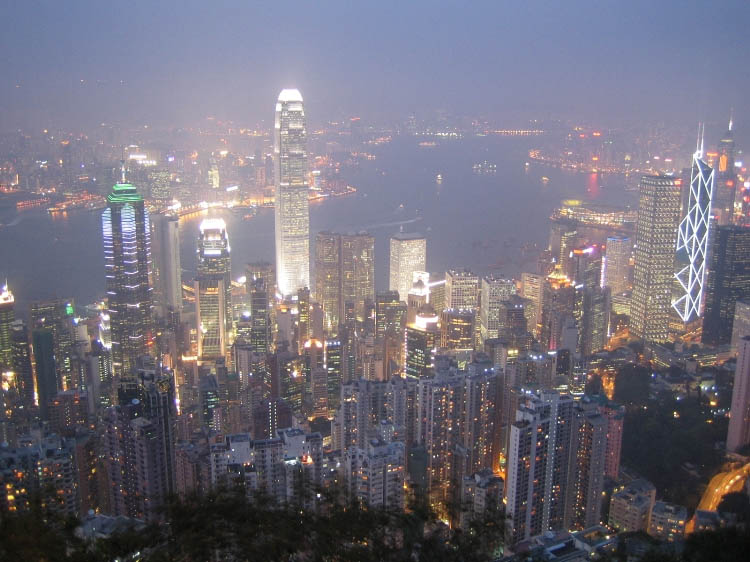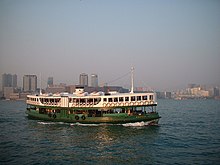Throughout its history, the harbour has seen numerous reclamation projects undertaken on both shores, many of which have caused controversy in recent years due to environmental concerns concerning water quality and natural habitats in addition to economic concerns that benefits of land reclamation may be less than the effects of decreased harbour width, affecting the number of vessels passing through the harbour. Nonetheless it still retains its founding role as a port for thousands of international vessels each year.
Long famous for its spectacular views, the harbour is a major tourist attraction of Hong Kong. Lying in the middle of the territory's dense urban region, the harbour is the site of annual fireworks displays and its promenades are popular gathering places for tourists and residents.

Geography
The following are major islands contained within the harbour
- Green Island
- Little Green Island
- Kowloon Rock
- Tsing Yi Island
- Hong Kong International Airport
- Stonecutters Island (now connected to Lai Chi Kok Bay, New Kowloon)
- Channel Rock (now connected to Kwun Tong, New Kowloon)
- Kellet Island (now connected to Causeway Bay, Hong Kong Island)
- Hoi Sham Island (now connected to To Kwa Wan, Kowloon)
- Nga Ying Chau (now connected to Tsing Yi Island, New Territories)
- Pillar Island (now connected to Kwai Chung, New Territories)
- Mong Chau (now connected to Kwai Chung, New Territories)
- Chau Tsai (now connected to Tsing Yi Island)
- Hong Kong International Airport
Tourism
The Victoria Harbour is world-famous for its stunning panoramic night view and skyline, particularly in the direction towards Hong Kong Island where the skyline of skyscrapers is superimposed over the ridges behind. Among the best places to view the Harbour is at the Peak Tower on the Victoria Peak, or from the piazza at the Culture Centre or the promenade of Tsim Sha Tsui on the Kowloon side. Rides on the Star Ferry to view the harbour are also widely popular.As the natural centre of the territory, the harbour has played host to many major public shows, including the annual fireworks displays on the second night of the Lunar New Year. These shows are popular with tourists and locals alike, and the show is usually telecast on local television. To add to the popularity of the harbour as a sightseeing location, the government introduced a show dubbed A Symphony of Lights
Also recently opened, was the Avenue of Stars, built along the promenade outside the New World Centre in Tsim Sha Tsui. Modeled on the Hollywood Walk of Fame, it honours the most illustrious people the Hong Kong film industry has produced over the past decades.
By the end of November every year, the outer walls of buildings in the central business districts on both sides of the harbours are dressed with Christmas-related decorations, and replaced with Lunar New Year-related ones by January.
Port facilities
Victoria Harbour is home to most of the port facilities of Hong Kong, making Hong Kong amongst the world's busiest. An average of 220,000 ships visit the harbour each year, including both ocean going vessels and river vessels, for both goods and passengers. The Kwai Chung Container Terminals in the western part of the harbour is the main container handling facility, operating round the clock and handling about 62 percent of the 21,930 TEUs handled by the territory in 2004. Some 400 container liners serve Hong Kong weekly, connecting to over 500 destinations around the world.For many years until 2004, Hong Kong handled the most containers (measured by TEUs), but it faces competition from the ports in nearby Shenzhen in recent years, with the ports in Shenzhen combined handling more containers than the Kwai Chung terminals since August 2004. Overall, the Hong Kong port has also lost out to the Port of Singapore in containers handled, with Singapore's port outpacing Hong Kong's since the first quarter of 2005.
Transport
There is no bridge crossing the harbour, but there are three cross-harbour tunnels: Cross Harbour Tunnel (opened 1972), Eastern Harbour Crossing (1989), and Western Harbour Crossing (1997). They connect Hong Kong Island and the Kowloon Peninsula across Victoria Harbour. The three tunnels act as important linkages between the Hong Kong Island and Kowloon.Three MTR routes also have tunnels under the Harbour. They are namely:
- Tsuen Wan Line
- Tseung Kwan O Line (parallel with Eastern Harbour Crossing)
- Tung Chung Line and Airport Express, which share the same pair of tracks in the tunnel
The Hongkong and Yaumati Ferry Company used to operate numerous cross-harbour routes between various piers of Kowloon and Hong Kong Island. Many of the routes are now operated by First Ferry. Some of the piers no longer exist because of reclamation projects, or many of the routes became unprofitable. Currently, the company continues to operate vehicular ferry services for vehicles carrying dangerous goods that are prohibited within tunnel crossings.
For international passenger traffic and traffic to mainland China and Macau, there are two ferry terminals, namely Hong Kong-Macau Ferry Terminal and Hong Kong China Ferry Terminal, and a terminal for cruises, the Ocean Terminal. Another cruise terminal (Kai Tak Cruise Terminal) has been proposed.





No comments:
Post a Comment